
Craft Airplane Extended is a high precision real-time plug-in for the animation of airplanes. The vehicle is controlled with an input device directly through 3ds Max or Maya. Craft Airplane Extended can be used to simulate movements for all types of vessels, from toy airplanes to jumbo jets. Craft Airplane Extended also has the ability to follow splines. The user links the model that will be rendered to Craft Airplane Extended to inherit its movements. Multi-player functionality allows two or more users to individually steer the Craft Airplane Extended dummies simultaneously.

|
Select the Craft Airplane Extended in the tool tree list and click on the Input settings button in the tool bar. This will open the input settings window for Craft Airplane Extended.
Read more about Input settings >>.
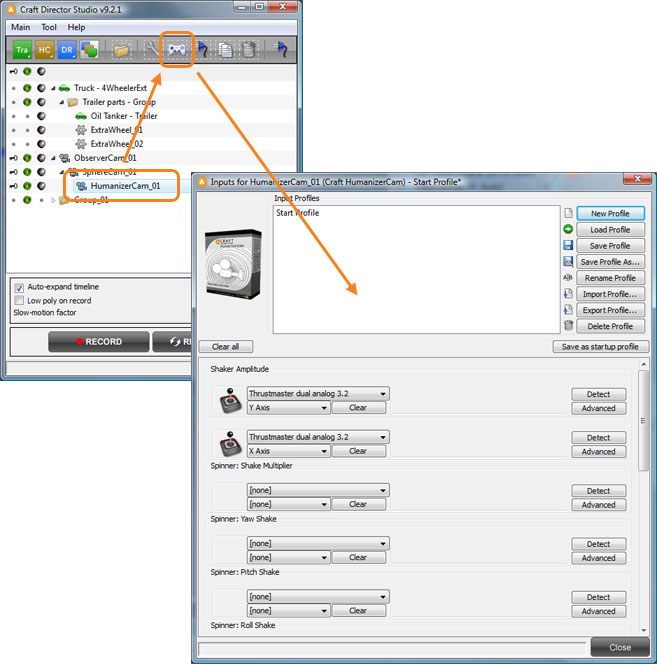
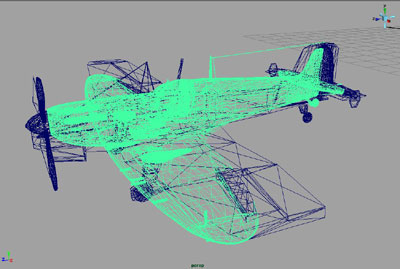
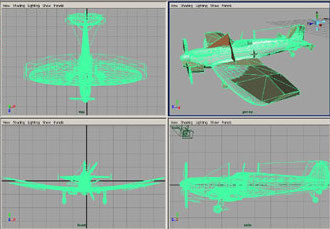
When Autonomous mode is activated, Craft Airplane Extended will follow the AirplaneExt_01_TargetMesh. This enables Craft Airplane Extended to follow a spline or other moving object.
Directions for making Craft Airplane Extended follow a path (spline):
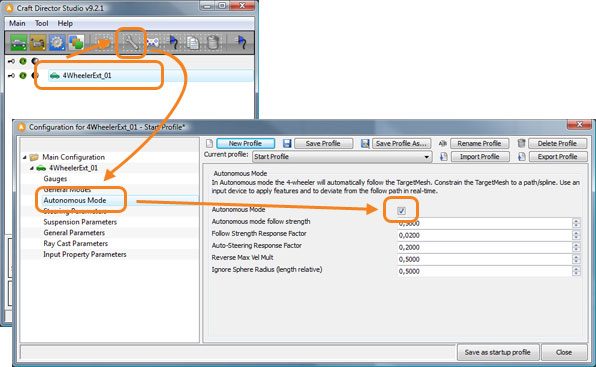


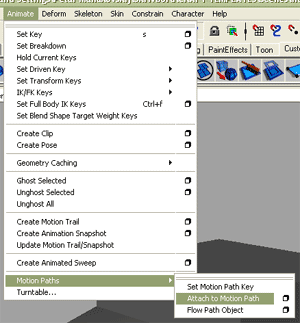
By using the Body Relocator Node (see illustration, AirplaneExt_01_BodyRelocatorNode), the animation can be fine-tuned after the recording has taken place. The Body Relocator can be keyframed according to specific needs. For example, it can be used to move the plane a bit to one side if one of the wings happened to cut through an object that the plane should have missed.
Maneuver example:

Propells the airplane.
Moves the plane right/left horizontally.
Lifts/lowers the plane vertically.
Turns the plane right/left.
Tilts the plane up/down.
Rolls the plane right/left.
Restores plane to horizontal position if Realistic Airplane Control is checked.
Shakes plane, simulating turbulence.
Simulates a collision.
Brakes the plane.
Enables the change of parameter values with a real-time input controller.
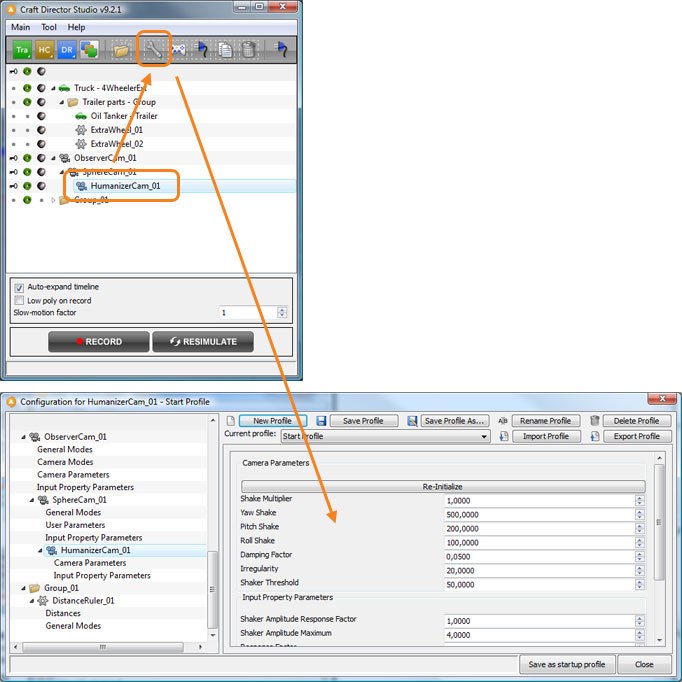
Initital Velocity (% of max)
It is the first of three ways to have an initial velocity if larger than zero where it is specified as a percentage of the maximum velocity. Second is to use a keyframed initial velocity. Third is to use a non-zero input value when record is pressed.
Multiplier
This value is pre-multiplied to the ‘Current Velocity’ below. Eg if the system unit is meters a multiplier value of 1 yields m/s. If the multiplier is 3.6 the result is km/h.
Current Velocity
This is not a value you can input. The measured current velocity of the vehicle in system units per second times the ‘Multiplier’ above.
Current Velocity (% of max)
This is not a value you can input. The current velocity of the vehicle in percent of the maximum velocity.
Initialize Velocity
When pressed the input device value is read and used as the initial forward velocity of the airplane.
Hide Helpers
Hides the helper objects.
Hide Helpers During Recording
Hides the helpers during recording.
Hide Cockpit Camera
Hides the Cockpit camera.
Hide Follow Camera
Hides the camera following the airplane.
FollowCam w all directions
The FollowCam will follow all orientations of the airplane.
Realistic Airplane Control
Checking this box will turn off all flight assistance for the plane making it harder to control but it will behave more realistically.
Use relative forward velocity
In this mode the airplane will stand still in the forward direction. When using this mode the surrounding is supposed to be animated because the airplane stands still.
Enable Autonomous Mode
In this mode the Airplane automatically follows the TargetMesh. The TargetMesh should be attached to the object the vehicle is to follow.
Roll with the Target
When enabled the roll is controlled with the roll motion of the TargetMesh. It is coupled to the ‘Realistic Airplane Control’ mode.
Follow Strength
This factor decides how tightly the Airplane follows the target.
Follow Strength Response Factor
The smaller the value is the slower the airplane auto fuctions respond to the target movements.
Yaw Strength
This factor decides how strong the yaw is when following the target.
Pitch Strength
This factor decides how strong the pitch is when following the target.
Roll Strength
This factor decides how strong the roll is when following the target.
Auto-Steering Response Factor
The smaller the value is the slower the airplane auto fuctions respond to the target movements.
Shake Offset Value
This value is alied to the input device value for ‘Shake Amplitude’ as an offset.
Turbulence Offset Value
This value is alied to the input device value for ‘Turbulence Amplitude’ as an offset.
Wind Strength
This value is alied to the input device value for ‘Up/Down Speed’ and ‘Left/Right Speed’ as a random wind gust offset.
Virtual Mass
This is used to simulate the weight of the airplane.
Shaker Fade Out Factor
This value determines how fast the shake effect will fade.
Turbulence Fade Out Factor
This value determines how fast the turbulence effect will fade.
Turbulence Frequency
This value determines how often the plane’s pitch is effected by the turbulence.
Rulier Angle Mult
Multiplies the Rulier by this factor.
Elevator Angle Mult
Multiplies the Elevator by this factor.
Right Aileron Angle Mult
Multiplies the Right Aileron by this factor.
Left Aileron Angle Mult
Multiplies the Left Aileron by this factor.
Forw/Backw Speed Response Factor
How fast the airplane’s Forward/Backward speed responds to the input device.
Forw/Backw Speed Maximum
The airplane’s maximum speed.
Right/Left Speed Response Factor
How fast the airplane’s Right/Left speed responds to the input device.
Right/Left Speed Maximum
How fast the airplane “strafes” right/left.
Up/Down Speed Response Factor
How fast the airplane’s Up/Down speed responds to the input device.
Up/Down Speed Maximum
How fast the airplane moves up/down.
Rulier (Yaw Right/Left) Response Factor
How fast the airplane’s rulier responds to the input device.
Rulier (Yaw Right/Left) Maximum
How fast the airplane turns right/left.
Elevator (Pitch Up/Down) Response Factor
How fast the airplane’s elevator responds to the input device.
Elevator (Pitch Up/Down) Maximum
How fast the airplane can change it’s pitch, up/down.
Aileron (Roll Right/Left) Response Factor
How fast the airplane’s aileron responds to the input device.
Aileron (Roll Right/Left) Maximum
How fast the airplane can roll right/left.
Horizontal Regulator Response Factor
How fast the airplane’s horizontal regulator responds to the input device.
Horizontal Regulator Maximum
How fast the airplane can even itself back to a horizontal position when this input is used.
Turbulence Amplitude Response Factor
How fast the airplane’s Turbulence Amplitude responds to the input device.
Turbulence Amplitude Maximum
How much the turbulence is effecting the airplane.
Shaker Amplitude Response Factor
How fast the airplane’s Shaker Amplitude responds to the input device.
Shaker Amplitude Maximum
How much the airplane shakes when the input is used.
Brake All Response Factor
How fast the airplane’s Brake All command responds to the input device.
Brake All Maximum
How quick the airplane brakes.